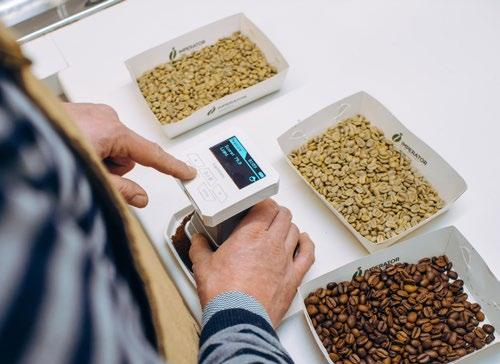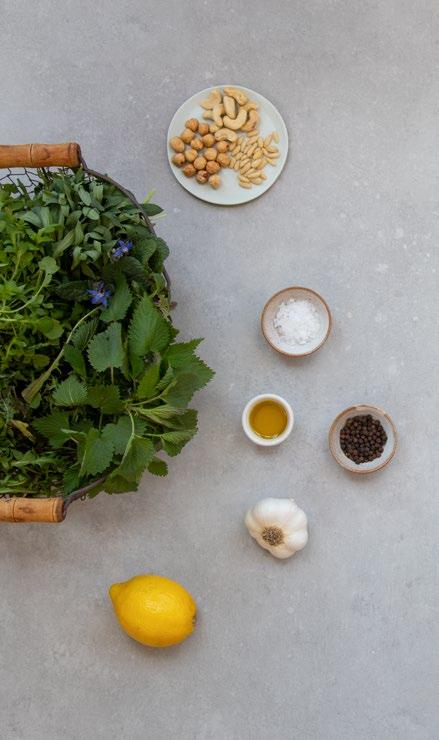
6 minute read
LA RICETTA
Pasta al pesto di erbe selvatiche
400g di pasta corta
Advertisement
1 spicchio d’aglio piccolo
1 mazzo di erbe spontanee miste
1 mazzo di rucola
20g di pinoli
40g di nocciole (idealmente tonda gentile)
40g di anacardi
100ml di olio extravergine di buona qualità scorza di 1 limone
50g di parmigiano reggiano
50g di pecorino sale, pepe
Sbollentare le erbe per un minuto e amalgamare insieme agli altri ingredienti in un mortaio o con un mixer. Versare in un’ampia ciotola, aggiungere la pasta scolata e mescolare bene. Servire con un filo d’olio extravergine, una grattugiata di scorza di limone o parmigiano.
Pasta with wild herbal pesto
400g short pasta
1 small clove of garlic
1 bunch of mixed wild herbs
1 bunch of rocket
20g pine nuts
40g hazelnuts
40g cashews
100ml extra virgin olive oil
1 lemon zest
50g parmesan cheese
50g pecorino cheese salt, pepper
Blanch the herbs for a minute and mix together with the other ingredients in a mortar or mixer. Pour into a large bowl, add the drained pasta and mix well. Serve with a drizzle of extra virgin olive oil and a grating of lemon zest or Parmesan cheese.
Oggi i vini macerati sono presenti nei migliori wine bar e nei ristoranti più importanti al mondo.
Today, macerated wines can be found in the world’s top wine bars and restaurants.
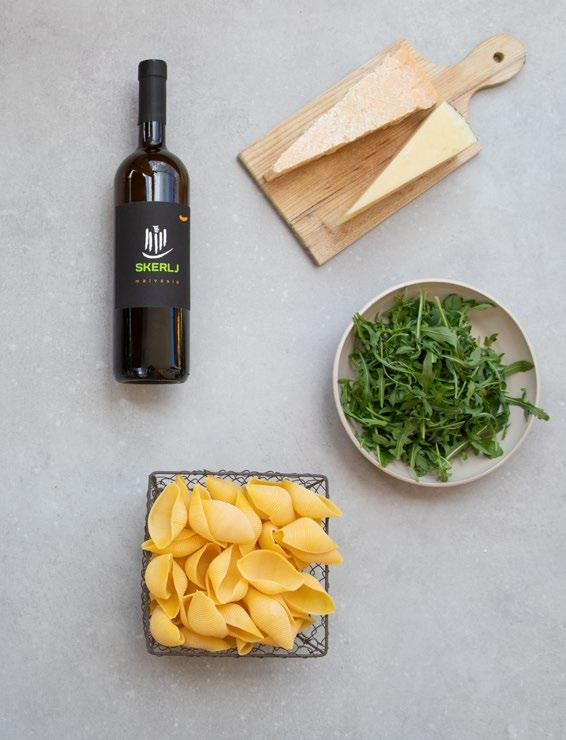
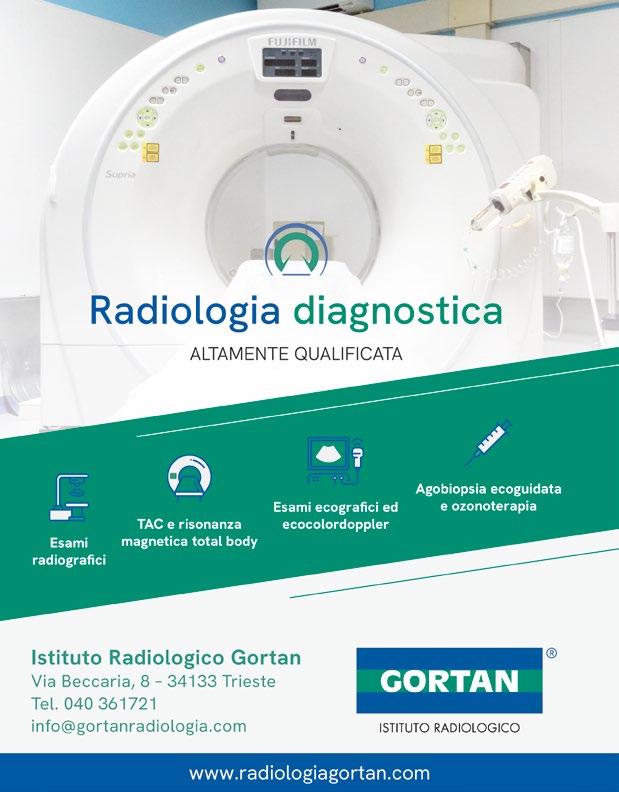
They looked at them with scepticism, considering them a passing fad far from the ‘noble’ world of ‘real’ wine. Until twenty years ago they were practically unknown. Today, macerated wines can be found in the world’s best wine bars and restaurants. And they are here to stay. Structured and complex wines, out of the box, fantastic in food pairings. It is no coincidence that less than two hours’ drive away, the multi-award-winning Hiša Franko –2 Michelin stars, 50 Best, Chefs Table– has for years been a temple of natural wine, with a great focus on macerated wines thanks to the expert guidance of Valter Kramar.
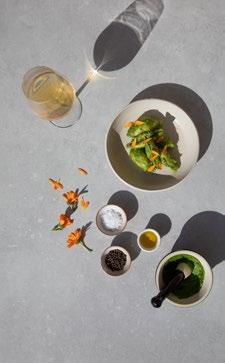
The winemaking technique is as old as wine and originates in Georgia (with traces dating back to 6000 B.C.) where the traditional ‘kvevri’, buried terracotta amphorae in which the grapes were left to macerate with their skins, are still used. It was in Oslavia, in the Collio region, that this technique was revived thanks to masters such as Joško Gravner and Stanko Radikon.
Gravner in 1997 was thought to have gone mad. No more barrique, no more international grape varieties, he abandoned the schemes of modern classical oenology. Madness, the prelude to genius. And geniuses, as you know, are often misunderstood at first and then hailed. Hosanna Gravner’s reign, he started a movement that transformed Collio, Karst, Slovenia and Istria into a revolutionary hub. Gravner is joined by Radikon in a pioneering vision followed by dozens of wineries in the area.
But in essence, what is it? Macerated wine is obtained from white grapes by processing it as if it were a red: maceration with the skins (from a few hours to whole months) allows the extraction of colour, tannins, complexity and flavour. It is a revolution that finds its best ally in natural wine because it is precisely maceration that makes it possible to minimise winemaking interventions in the cellar.
Trieste has been offering them for some time now, and our Karst boasts excellent producers such as Zidarich, Škerk, Skerlj and Vodopivec. To enter this world we recommend La Bottiglia Volante on P.za Sant’Antonio, Mood in the Jewish ghetto, Mimì e Cocotte in Via Cadorna, the artisan bakery Pagna in Via Muratti or the wine shop Tutt* in Via dell’Annunziata. If that is not enough, Amber Wine Festival will be held on 21 and 22 May at the San Giusto Castle, which will allow the tasting of some of the best macerates in a breathtaking location.
They are perfect with mature cheeses, more structured fish dishes, fried food, white meat, lamb, tasty vegetables and spicy dishes. We propose a slightly ‘wild’ seasonal recipe. A vegetable dish with an aromatic complexity that goes perfectly with a structured macerate such as Malvasia by Skerlj. If you are not into foraging, don’t worry: you will find bunches of ready-to-use wild herbs in markets and shops. Look for (not all together) nettle, dandelion, silene, wild garlic, hops, poppy, mallow, borage or wild chicory.
Il caffè è tra le bevande più consumate al mondo ed è un rito che ci accompagna ogni mattina da diversi secoli, ma il modo in cui questa bevanda viene gustata è cambiato molto nel corso del tempo. Proprio la sua versatilità e capacità di adattamento, ha fatto sì che il caffè conservasse la sua anima modaiola. Le mode vanno, vengono e spesso ritornano, come fossero onde sempre in movimento a contatto con la costa. A Trieste, per molti la capitale del caffè, questo parallelismo risulta decisamente azzeccato, in quanto ci si riferisce ai diversi periodi storici in cui si è trasformato l’approccio alla produzione, alla preparazione e al consumo del caffè, proprio con il termine “ondata” (wave). La terza, quella attuale, è quella che ha visto nascere i cosiddetti specialty coffee, caffè di alta qualità tracciabili e più sostenibili. Si va oltre quindi alla semplice dicitura Arabica e Robusta che identifica solo le due specie più commercializzate al mondo (un po’ come dire vino bianco o vino rosso), ma si distinguono le diverse zone di provenienza, la lavorazione e il tipo di tostatura. Per la preparazione degli specialty coffee anche il menu si fa più ricco. All’espresso, che è stato l’elemento distintivo della seconda ondata, a partire dagli anni ‘60, si affiancano le cosiddette preparazioni alternative. Ecco quindi comparire ormai in qualsiasi caffetteria moderna diversi sistemi a percolazione manuale o meccanica e l’ultimo arrivato in ordine di tempo, l’Aeropress, sistema a pressione manuale divenuto estremamente popolare per la sua facilità di utilizzo e trasportabilità.
Entrare in orbita Bloom, la realtà tra le più innovative di Trieste in tema caffè, significa esplorare un nuovo modo di concepire questa materia. Un luogo dove si miscelano tradizione e nuove tendenze, dove potrete avanzare professionalmente attraverso i diversi programmi formativi di Bloom Coffee School: Barista, Brewing, Analisi
Coffee is hip!
sensoriale, Tostatura e Caffè verde. Se invece siete dei semplici appassionati potrete scoprire la tostatura sartoriale di Bloom Specialty Coffee. Vi guideremo tra blend e singole origini tostate con diversi profili in modo che possiate letteralmente cucirvi addosso il caffè che desiderate. Inoltre potrete esplorare nuovi metodi di estrazione, da casa o da viaggio, oppure farvi consigliare i trucchi del mestiere per utilizzare al meglio ciò che state già utilizzando. Il tutto nel cuore della capitale italiana del caffè, in Campo del Belvedere a Trieste!
Pensate in modo diverso e non resterete mai indietro. Parola di Bloom!
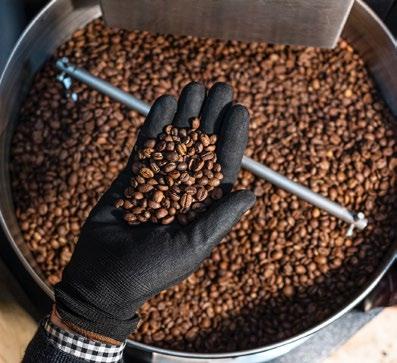
Coffee is one of the world’s most consumed beverages and has been part of Italians’ morning ritual for centuries – yet, the way coffee is brewed and served has undergone numerous changes over time. Nevertheless, thanks to its versatile and adaptable nature, coffee has never stopped being hip. Trends go in and out of fashion, often finding their way back like waves on the foreshore. This is particularly true in Trieste – by all accounts the capital of coffee, whose alternating trends production, preparation, and consumption are, indeed, called “waves”. The current fashion, also known as the “third wave of coffee”, is specialty coffees, namely coffees of the highest grade available, typically referring to the entire supply chain, including sustainability. The mere distinction between arabica and robusta is now as off the point as would be a classification of wine based only on the distinction between red and white. Specialty coffee is carefully selected on the basis of its origin, farming, and roasting – and, perhaps not surprisingly, a richer brewing and serving menu. Espresso, the real protagonist of the second wave in the ‘60s, must now compete against alternative preparations: modern cafés use manual or mechanical percolation, together with the latest brewing method, Aeropress, which follows the same principles of French press machines, while providing increased portability and ease of use.
As you step into Bloom café, you are entering a whole universe devoted to coffee and its most innovative features, based on the careful analysis of the raw material. This is where tradition and new trends meet and mingle, and professional knowledge is codified and disseminated through the various training courses of Bloom Coffee School: Barista, Brewing, Sensory analysis, Roasting, and Green Coffee. If you are a coffee enthusiast, you are welcome to discover our Bloom Specialty Coffee tailored roasting: our staff will guide you through blends and single-origin beans undergoing different roasting methods, so that you can select the roasted blend that best suits your needs. Here you can also learn about the latest extraction methods, including home extraction and extraction on the go, or ask our baristas about tips and tricks to make the most of your coffee machine. Visit us in Campo del Belvedere, in the heart of Italy’s capital of coffee!
Think outside the box and you will never miss out. Word of Bloom!
